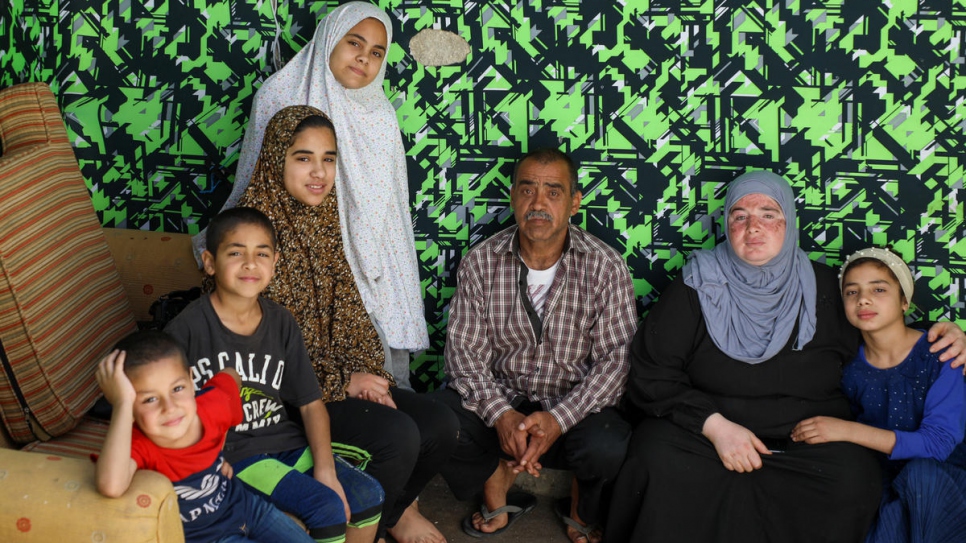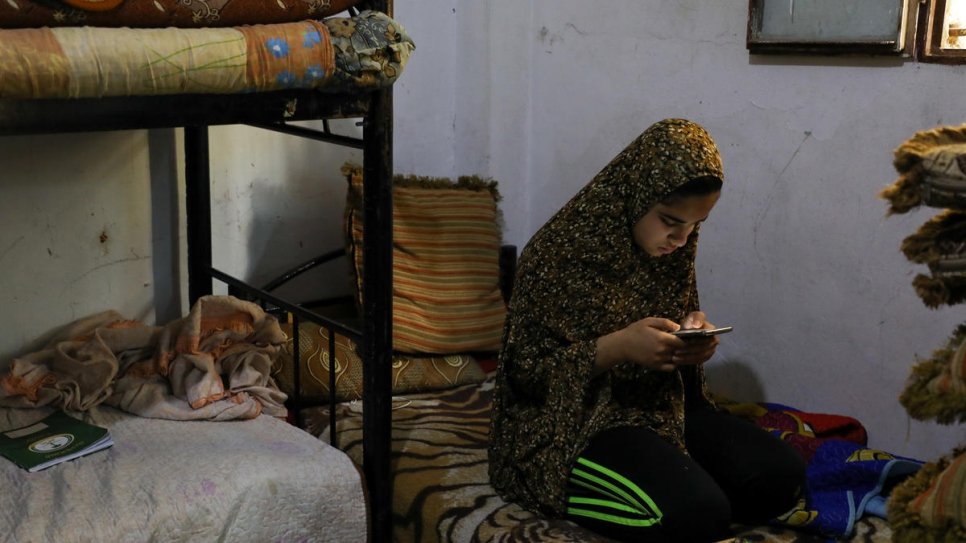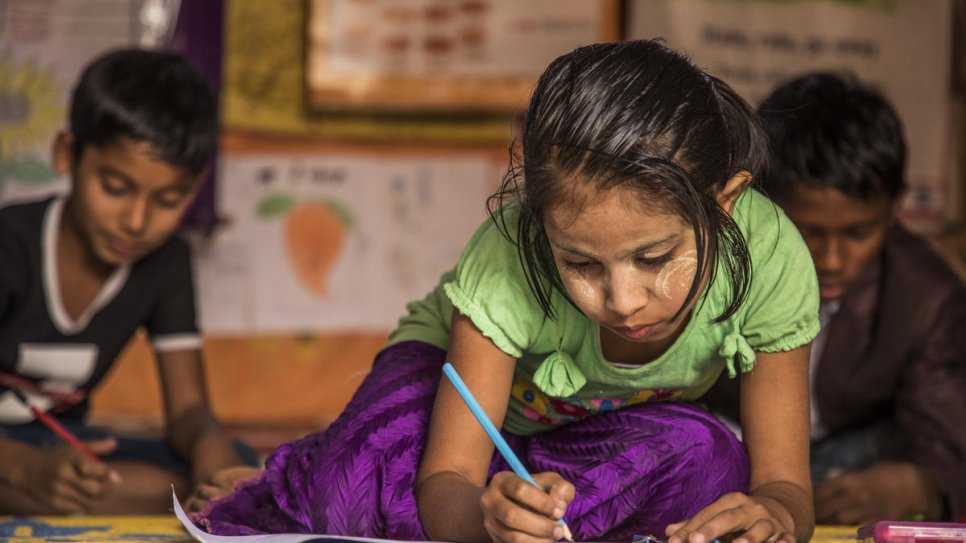Refugee children hard hit by coronavirus school closures
Going to school was already a daily challenge for many displaced children around the world. Now there are fears some may not return after COVID-19 lockdowns lift.
Muhammad, 10, says he has been very bored at home during the last month of coronavirus curfews in Jordan. A refugee from Syria, he lives with his parents and four siblings in a small apartment in East Amman.
© UNHCR/Lilly Carlisle
Going to school was already a daily challenge for many displaced children around the world. Now there are fears some may not return after COVID-19 lockdowns lift.
Isai* missed two years of school while his family was avoiding social unrest in his home country of Nicaragua and then fleeing first to neighbouring Honduras, and later to Guatemala.
At the age of eight, he finally returned to the classroom at the start of Guatemala’s school year in January. His mother, Lisseth,* said he had just started making friends when COVID-19 hit the country and the government ordered the closure of all schools.
“He had only two months of experiencing school life before everything shut down,” said Lisseth. “He’s very sad and distressed. For him, it is like being in Nicaragua all over again.”
Even before the coronavirus pandemic shuttered schools around the world, disrupting the education of almost 1.6 billion students according to UNICEF, classrooms were closed to millions of displaced children.
Less than half of school-aged refugee children were enrolled while only one in four were attending secondary school. Months-long school closures risk reversing small gains recently made in expanding access to education for refugee children.
"There's a big risk that inequalities in education will widen."
“There’s a big risk that inequalities in education will widen,” said Rebecca Telford, education chief for UNHCR, the UN Refugee Agency. She noted that while many countries have acted quickly to roll out distance learning programmes, there have been few targeted interventions to ensure they are accessible for refugees.
“The challenge is about access, and whether people have a phone, or other hardware at home,” she said. “Families might also not be able to afford data. Many refugee camp settings are in remote areas which aren’t reached by FM signals from national radio stations, so people can’t listen to educational broadcasts.”
Since schools closed in Jordan in mid-March, Mustafa and Sherin, refugees from Syria who live in East Amman, have had to draw up a schedule to make sure each of their five children has a turn using the family’s one TV and one mobile phone to do their school work.
Jordan’s education ministry is broadcasting classes on TV and mobile companies are providing free data to access an online learning platform, but Mustafa said he has had to buy additional data for WhatsApp which his children’s teachers use to send videos. The added spend on data has forced the family to cut back on other expenses.
The lockdown has also prevented Mustafa from earning his usual living collecting discarded plastic and metal for recycling while Sherin has not been able to do cleaning work. The family are relying on the 150 Jordanian Dinars (US$211) a month in cash assistance they receive from UNHCR to continue paying for food and rent – support that is not available to all refugee families.
Twenty-three per cent of Syrian refugees in Jordan have no internet access at home and 46 per cent surveyed in a recent needs assessment said their children were not accessing the government’s online learning platform.
See also: Refugees across Arab world feel economic pain of coronavirus
While children from low-income families in host communities are similarly affected by the digital divide, refugee children – many of whom have previously had prolonged absences from school – are also missing out on much-needed additional assistance available through their schools such as language classes and psycho-social support.
Following school closures in Bulgaria, refugee children initially struggled to participate in online education partly because they lacked devices, but also because of the language barrier, according to Borislav Grozdanov, a public information associate for UNHCR in Bulgaria. The Council of Refugee Women and the Bulgarian Red Cross are now providing donated laptops and tablets to refugee families and another NGO, Caritas Sofia, is offering online language courses.
“All of my five children … are taking part in the online language courses,” said Wisam, a refugee from Syria who now lives in the Bulgarian capital. “I am very happy … they can continue practicing the language. But online courses can’t replace school. My children want to go back to school because they miss their friends and their teachers.”
Keeping children in school in gang-wracked Honduras is seen as a key plank in a push to prevent fresh violence and displacement. In urban areas of Honduras – where children are often recruited or targeted by criminal gangs – schools are one of the few places where they can feel safe.
“School can save children from the gangs,” said Luis*, the principal of a school in a low-income area of Tegucigalpa, the Central American nation’s capital. “We aren’t just teachers – we’re psychologists, advisors, guides.”
Since schools closed, he said his students were struggling to keep up with their lessons at home as many could not afford internet plans and lacked TV sets that would allow them to follow the government’s educational broadcasts.
Half a world away in Bangladesh, Rohingya refugee children living in sprawling settlements in Cox’s Bazar, had limited access to education even before a lockdown went into effect last month as a public health measure to limit the spread of COVID-19. Schools throughout the country have closed as well as learning centres in the camps.
Aid groups had been preparing to launch a pilot programme that would allow children in the settlements to start learning from the Myanmar curriculum for the first time, following the welcome approval of the Bangladesh government in January. In the meantime, hundreds of informal temporary learning centres were offering a basic education and a chance for children to forget the daily struggles they face in the overcrowded camps.
Babu Nisa, a refugee teaching assistant at one of the learning centres, said her students were “very upset” when they heard it would be closed as part of the lockdown.
"Learning centres are not for studying only. They grow here."
“Learning centres are not for studying only,” she said. “They grow here. They enjoy their time and snacks here, along with education. The camp is a congested place and living conditions in the shelters are not suitable for the students to study properly.”
As ongoing restrictions on mobile internet connectivity in the camps make online learning impossible, UNHCR and its partners have been distributing guidelines for parents and caregivers to help children do some learning at home and advocating for internet connectivity to be re-established within the camps and surrounding host communities. Babu and her colleagues are also trying to visit their students who live close by.
“We motivate them so they do not lose hope and feel sad. They like to study but we cannot ensure the environment for them at home,” she said, explaining that many parents are unable to help their children because they lack literacy skills.
As well as developing and distributing printed learning materials, UNHCR is working with national governments and NGO partners to support teachers, parents and students while schools remain closed.
In several countries, that has meant continuing to pay incentives to refugee teachers and helping them adapt to the new reliance on digital technology.
Robert Kinyanjui, a secondary school teacher in Kenya’s Dadaab camp, said teachers there were using various methods to ensure learning continues, including conducting lessons through WhatsApp groups, radio broadcasts and even audio recordings.
He added that students in the camps remain eager to learn and take advantage of all the available opportunities, despite the challenges.
“We follow up on those students whose participation in the alternative education programme is poor,” he said.
In countries where online learning is less available, such as South Sudan and Niger, the focus has been on distributing self-study packs and radios so refugee children can follow along with lessons broadcast by community radio stations.
Jennifer Roberts, a senior education officer with UNHCR, said that school closures have prompted some innovations in the delivery of educational support services and the use of digital technology that may prove invaluable as schools start preparing to safely re-open.
“Responding to the pandemic gives us the opportunity to build back better and improve the resilience of systems,” she said.
Lessons drawn from previous prolonged school closures, such as during the Ebola outbreak in West Africa, show that adolescent girls are most at risk of falling behind and not returning when schools re-open.
“We need to start thinking now about tailored interventions to support them,” said Roberts, adding that catch-up clubs for girls were used successfully after the Ebola school closures.
Luis, the school principal in Tegucigalpa, is faced with a more fundamental problem. One of the gangs that terrorizes the area quickly took advantage of the fact the school was empty to take it over as a headquarters for their operations.
“I’m worried they won’t give it back,” he said.
*Names changed for protection reasons
Writing by Kristy Siegfried, with reporting by Alexis Masciarelli in Guatemala City, Pamela Villars in Tegucigalpa, Lilly Carlisle in Amman, Iffath Yeasmine in Cox’s Bazar, Caroline Opile in Nairobi and Borislav Grozdanov in Sofia.
See also: As COVID-19 pandemic continues, forcibly displaced children need more support than ever





